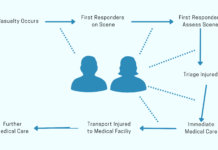In 1878, the brothers’ father, Milton Wright, brought home a rubber band powered toy helicopter. Designed by French aeronautical experimenter Alphonse Pénaud, this toy did not simply fall to the ground as expected. Rather it “flew across the room till it struck the ceiling, where it fluttered awhile, and finally sank to the floor.” Though the fragile toy soon broke, Wilbur and Orville never forgot it. They even attempted to build their own toy helicopters. In later years, Orville accredited this childhood toy as being the object that sparked their interest in flight.
Throughout their lives, the brothers were involved in a variety of ventures to make money. But it wasn’t until 1892, when they formed the Wright Cycle Company to sell bicycles, that they found a successful business that also allowed them spare time for other projects. With the business doing rather well, the brothers also opened a repair shop and later began to manufacture bicycles.
The brothers knew that the solutions to lift and propulsion needed only refining, but no one had achieved lateral control. Rejecting the principle of inherent stability – the conventional wisdom – they wanted control to depend on the pilot. Wilbur hit upon the idea of warping the wings – sparked by his observation of birds and the idle twisting of a box – to rotate the wings and stabilize flight. They tested wing-warping – the forerunner of ailerons – on a 5-foot biplane kite
The 1902 machine embodies the Wrights’ research. They gave it efficient 32-foot wings and added vertical tails to counteract adverse yaw. The pilot moved a hip cradle to warp the wings. Some 400 glides proved the design workable, but still flawed. Sometimes, when the pilot tried to raise the lowered wing to come out of a turn, the machine instead slid sideways toward the wing and spun into the ground. Orville suggested a movable tail to counteract this tendency. After Wilbur thought to link the tail movement to the warping mechanism, the plane could be turned and stabilized smoothly. If others had thought about steering at all, it was by rudder – a marine analogy unworkable in the air.
Then, on a remote, sandy beach, in the year 1903, he broke our bond to the earth. He flew. It lasted only 12 seconds, and the distance of the flight was less than the length of an airliner. But for the first time, a manned, heavier-than-air machine left the ground by its own power, moved forward under control without losing speed, and landed on a point as high as that from which it started. Within two generations we had taken to the air for routine travel, seen an aircraft break the sound barrier, and watched a man walk on the moon.
Reflexive Analysis
The story of the Wright brothers is the focus of the National Park in Dayton, Ohio. During our visit there I learned more about the history of developing flight and the kinds of emotions/ideas associated with their story than the science behind flight itself. This article breaks down the main bullet points in the story of first flight. From the moment they were inspired by a toy to the moment the first machine got itself off the ground. The interactive display above is in the museum at the park and shows that first moment of infatuation. The Park Service uses similar toys to illustrate this excitement currently. Understanding the story of the Wright brothers will be critical in adapting a design problem that fits our prompt as their story is woven through all aspects of the park and its activities.

Sources
U.S. Department of the Interior. (n.d.). The road to the first flight. National Parks Service. https://www.nps.gov/wrbr/learn/historyculture/theroadtothefirstflight.htm#:~:text=In%201903%2C%20Wilbur%20and%20Orville,off%20and%20on%20since%20childhood




